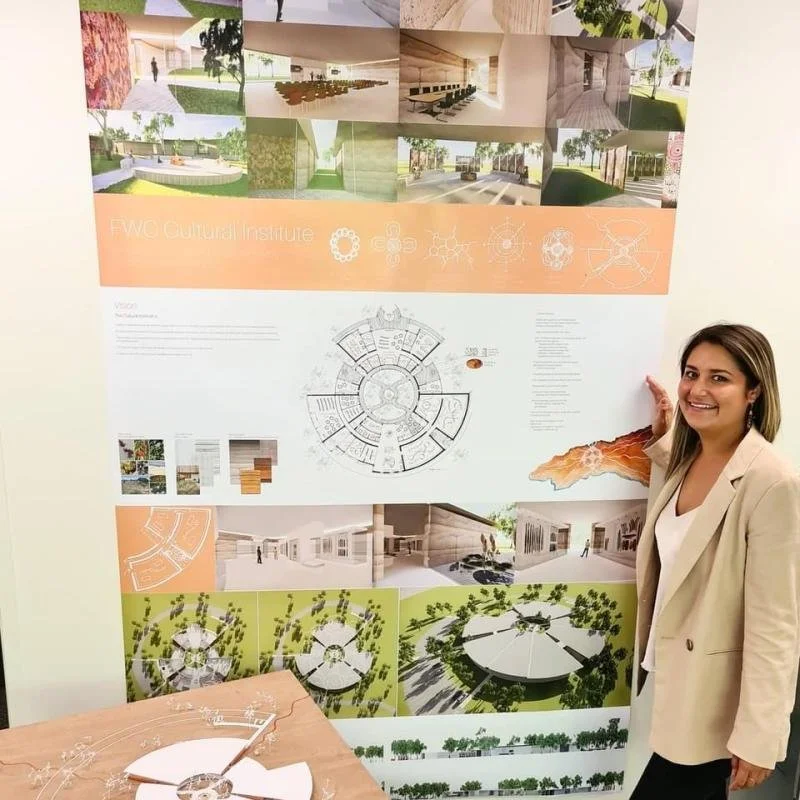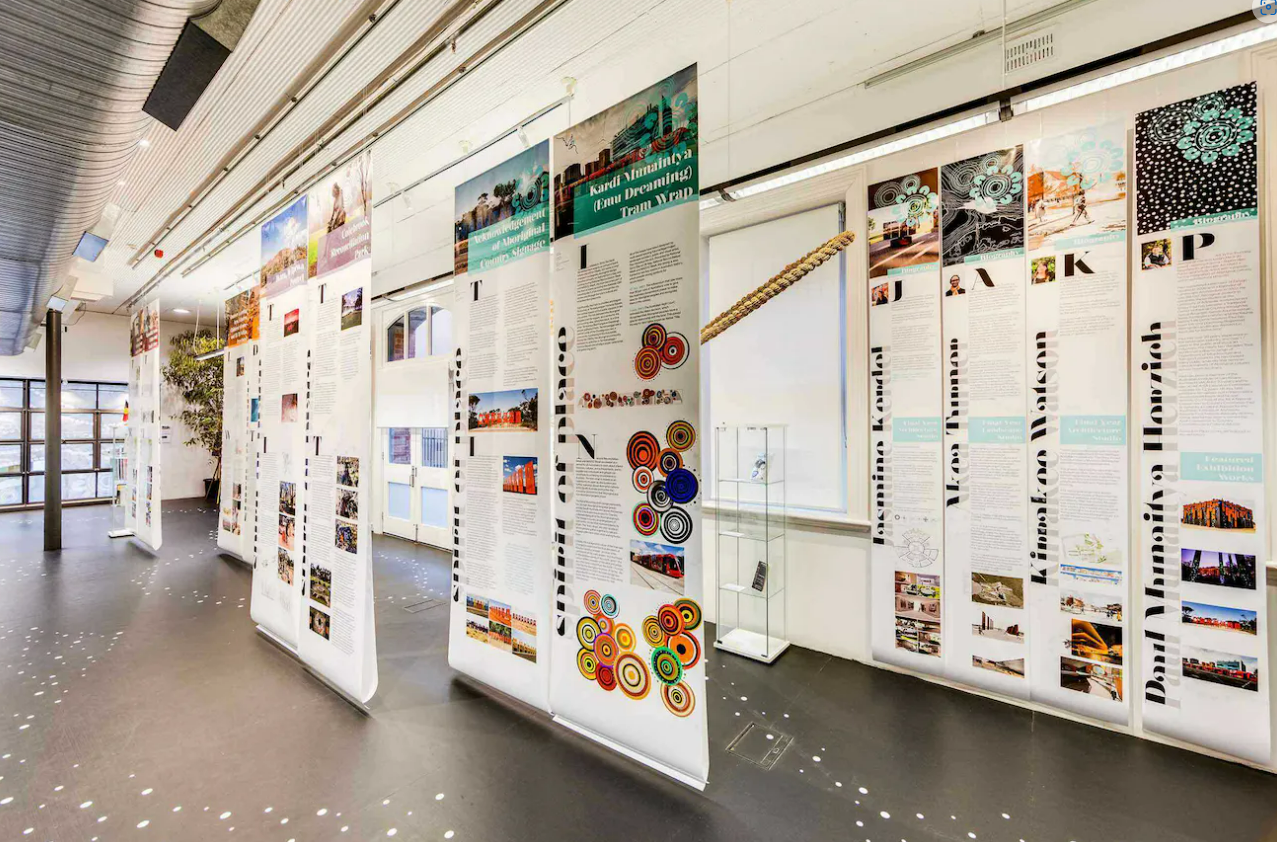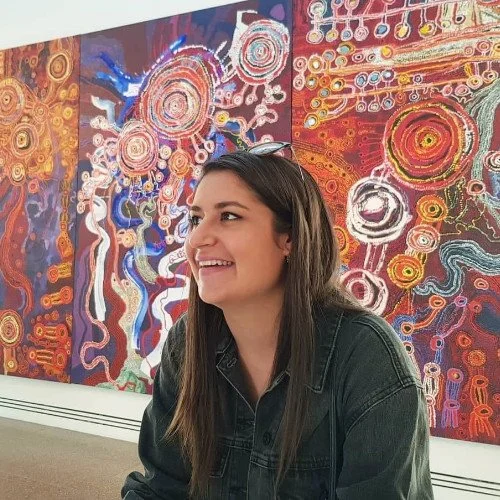




A CASE FOR MORE INDIGENOUS AUSTRALIAN ARCHITECTS
April, 2023
SA Designers for Diversity is a task group within the local SA Chapter of the AIA. Conversations in that context around how best to highlight the diversity of participants in the built environment revealed that a young Indigenous Australian had graduated in 2021 with a Master of Architecture from Uni SA. Her name is Jasmine Kerdell. This led to me seeking Jasmine out to hear and share her story and to thinking of the broader context of Indigenous Australian architects generally and the perspectives they might bring to the practice of architecture. Following this thread is what eventually became the following article.
Diversity is a key pillar of successful, progressive society. Each of us brings a perspective based on where we’ve come from and our experiences to this point. Diversity of background brings with it diversity of thought and that’s what makes for exciting community. From this, all things are possible.
And yet.
As at the 2016 census, only 28 registered architects were Indigenous Australians. Just one more than the previous census, five years prior. (Architects Accreditation Council of Australia 2018). This is a disproportionately low number – about .2% of the population of Australia. Given that Aboriginal and Torres Strait Islander peoples make up around 3.2% of the population, and there are about 12,000 architects in Australia, to achieve parity of numbers there should be roughly 350 to 400 Indigenous Australian architects.
I posit that a greater number of First Nations people in the profession would benefit us all and the built environment in myriad ways, adding different perspectives and enriching outcomes, in no small part by embracing the ethos, “if you look after Country, she will look after you”. (Lane 2022)
As our profession begins to move beyond sustainable design and towards regenerative architecture, incorporating this framework into thinking around the best design outcomes will help us to consider and care for Country alongside other stakeholder groups.
Country in Indigenous Australian philosophy of course is not just the land and it’s not just physical. Jasmine Kerdel - more on Jasmine later - explains that it’s a layering of the land with the people and culture, the animals, the sky, water, plant life, the rocks, the spirit, and the history of a place. Everything is connected. One does not exist without respect for the other and this knowledge permeates any design process. The success with which Aboriginal peoples of Australia have husbanded the land for millennia is due at least in part to this deep listening to and respect for Country.
There are many fine practices already integrating this knowledge into their work. Arguably, more First Peoples’ practitioners may help a larger number of us to understand and integrate this philosophy into our own work.
This also is not to suggest at all that any and every Indigenous Australian architect will have the inside knowledge to all areas of Australia. Each site will have its own specific environmental and cultural imperatives known mainly by the local mob. Perhaps though, Indigenous Australian architects might better intrinsically have different questions to ask and an understanding and perspective of what might be relevant and important in each space. They will add a different perspective.
So how can we encourage more Indigenous Australians into the field? Until we have practitioners enough to provide more visibility and mentorship within the many Indigenous groups, what can be done to introduce the possibility of a career in architecture to Aboriginal and Torres Strait Islander students around the country?
Ideally, the possibility of a career in architecture would be introduced to children at primary school level. This would give time for the idea to ferment, normalise, be pondered on. Carroll Go-Sam, a senior lecturer at the University of Queensland’s School of Architecture (UQ), in an article for Australian Design Review describes the UQ Pathways program which connects to primary schools. It invites Indigenous children from five to ten years of age to come in for a day and see what the university students do with a view to increasing awareness of architecture as a potential career path. (Russell 2020)
For high school students, the Aboriginal and Torres Strait Islander Studies Unit at UQ offers the InspireU Program, designed to engage, inspire, and promote tertiary education generally. (The University of Queensland n.d.)
Once at university level, there are a few Architecture scholarships available to Indigenous students.
Western University has one, funded by DesignInc for new or existing Aboriginal and Torres Strait Islander students. (ArchitectureAU 2019). The University of Sydney has an undergraduate and post graduate coursework scholarship up to $10,000 for the duration of the degree (University of Sydney 2021), and the University of South Australia offers the Scholz Vinall Aboriginal Scholarship to a total value of $15,000 (University of SA n.d.).
The Droga Indigenous Architecture Scholarship Program at UTS was established in 2019 to develop “meaningful representation in Australian architecture of Indigenous professionals”. (University of Technology Sydney n.d.).
One of the first recipients of this scholarship was Marni Reti. Ms Reti went on to receive the 2021 NSW Architect’s Medallion, awarded to a NSW graduate who has achieved distinction both in a particular subject area at final level and generally throughout the two years of the course. Currently, she is employed as a graduate by Kaunitz Yeung Architecture and by UTS as Masters Design Studio Leader. She is an advocate for bringing Indigenous knowledge keeping and traditional practices to architecture students to “create a richer Australian architectural vernacular; rooted in Country, culture and community”. (Reti n.d.) On bringing Indigenous knowledge to the profession, she says she has “always felt very strongly against this misconceived notion that because we have trained for five years in a western institution that we know what belongs on country better than an Uncle who has spent his entire life dedicated to its care or an Aunty who never got to go to university but has a wealth of knowledge about design and Country”. Further, she believes “there is no reason architecture cannot contemporise Indigenous culture with the permission of Elders”. (Architecture news and editorial desk 2021)
We have in our midst Indigenous Australian architecture graduate, Jasmine Kerdel. I met Jasmine to discuss this idea of encouraging more Indigenous Australians into architecture and our conversations ranged far and wide, and beyond the original theme, largely to help me to understand some of the differences between Aboriginal culture and the one that I inhabit.
Jasmine and her two sisters grew up in a household that merged two cultures, that of her Indigenous Australian mother and her white father and I was curious to know what the differences might look like.
A couple of examples of these differences. First, the concept of time. In the western world, we tend to look at time in a linear form – horizontally; the past is behind us, the future is in front of us. In the (very excellent) book, “Sand Talk” by Tyson Yunkaporta (Yunkaporta 2021), the author says there are no words in English to describe the Indigenous Australian concept of time. The closest he could come up with is ‘non-linear’, which he acknowledges is unsatisfactory, as it describes what it is not, not what it is. As Jasmine explains it, in the Aboriginal world, time is more vertical; we are here now, the past is below us, beneath our feet. The future is above. It’s a difficult concept to get my head around, but I understand it to mean in part that Aboriginal people are more attuned to the past, more aware of the many layers of history; where we are now is the natural consequence of all those steps before.
In practical terms, on her Dad’s side of the family, being ‘on time’ is more important than on her Mum’s side, where time has a looser, more flexible structure.
Another more poignant difference is in the family get-togethers. On Dad’s side, the big family get togethers are for weddings. On Mum’s side, they are for funerals, of which there have been many over the course of Jasmine’s life.
Jasmine’s love of architecture grew naturally from a creative disposition and was cemented with a work experience stint at Scholz Vinall while still at school. Here, the model making / cubby building / arty girl found a natural outlet for all that creative energy and her path became clear.
Bringing this enthusiasm to uni life, she graduated from Uni SA with her Master of Architecture in 2021. She loved the studio time especially, working with a brief, forming a narrative, investigating the history of a place. Wirringka, at Uni SA is a space for Indigenous students and this provided valuable support and a study place where students of all disciplines could meet and connect. An oasis of sorts.
Jasmine’s diligence was rewarded, winning the Gavin Walkley Community Engagement Grant Scholarship (for the design of a community centre for the Far West Coast Aboriginal Corporation), the Yangadlitya Aboriginal Postgraduate Scholarship and the inaugural Scholz Vinall Aboriginal Architecture Scholarship.
In 2021, she was invited to serve on the jury for the exhibition; Spirit of Place: South Australian contemporary Aboriginal architecture, landscape architecture and place making, an experience she very much enjoyed, and giving her the opportunity to work with Elizabeth Grant, Paul Munaitya Herzich and others.
Jasmine is keen to combine her love of architecture with community engagement work, working to create socially sustainable and thriving communities. Using modern technology with Aboriginal knowledge. She believes communication is the key, critical to a successful outcome. Adequate time must be available for connections and conversations to evolve, and engagement must continue for the duration of the design process.
She has some experience in this space with the work she has done with Woods Bagot as part of their Graduate Program in the design of Tarrkarri, a new $200m Centre for first Nations Cultures at Lot 14 in Adelaide and in the design for a new home for the Wathaurong Aboriginal Co-operative in North Geelong, Victoria. Tarrkarri is marketed as “a living cultural centre … connecting the timeless stories, rich traditions and diverse cultures from the Dreaming into the future”. Jasmine believes it will also act as a centre for all Aboriginal groups. Working with the New York team on that project (Diller Scofidio and Renfro) was an interesting exercise and one that necessitated explaining an alternate way of thinking. Something it seems that requires attention on a regular basis.
Country, for Jasmine, is Wirangu, Kokatha and Mirning Lands, together stretching from Point Culver in Western Australia to near Streaky Bay in South Australia (incorporating much of the Nullabor Plain) and to the north including Roxby Downs and Woomera. A city dweller, returning to Country for regular visits provides a refresh and renewal. This is the power of connecting with Country. Where I might talk about mindfulness, there is an Indigenous practice called Dadirri. Dadirri is deep listening and quiet awareness. As I understand it, listening deeply to Country will tell you everything you need to know.
Jasmine is passionate about architecture and about her Aboriginal heritage, culture, and community. She is currently considering where to next. It needs to be a place that she can combine these passions and operate at the interface, bringing knowledge about Country to the non-indigenous population. She infuses a thoughtful confidence and I’m excited for her future and for what she will bring to architecture.
UTS Professor of Architecture Anthony Burke talks about the “enormous untapped wealth of Indigenous knowledge that has never made it across the threshold into architectural practice or environmental design” and of the potential benefits and resource to the profession of that knowledge. (Power 2018)
It will be important for architectural practice to get behind this. Carroll Go-Sam notes there needs to be strong industry support for Indigenous graduates, with less than five percent of graduates in practice; architectural practices offering placements to Indigenous students and graduates would be a welcome initiative in a competitive industry. (Russell 2020)
Towards this end, Career Trackers is a national non-profit that supports pre-professional Indigenous university students and links them with employers over many sectors. Jasmine Kerdel is a successful alumnus of this program.
I get a sense just now that we are at a moment in time, overdue as it is, where there may be a growing readiness by non-Indigenous Australians to move forward together with Indigenous communities and individuals. The widespread acceptance of the Uluru Statement from the Heart is evidence of this. That non-Indigenous practices are beginning to work out their Reconciliation Action Plans (RAPs) is another. A call out from the creative directors of the 2023 Venice Biennale to hear what architectural practices are “contemplating, testing, and undertaking” around decolonisation is one more.
To seize this moment and tap into Indigenous knowledge in a meaningful way, it would be useful to achieve at least parity of numbers of Indigenous Australian architects with their non-indigenous counterparts. Aboriginal and Torres Strait Islander architects will bring an understanding of Indigenous culture, community, and environment to contemporary architectural practice. An important perspective to add to the mix.
It’s time for us to meet this Indigenous knowledge where it is, with the people that hold and nurture it, and maybe for more of us to practice Dadirri so that we too can listen to Country. And then Country can tell us what she needs.
Works Cited
Architects Accreditation Council of Australia. 2018. Industry Profile. February.
Architecture news and editorial desk. 2021. NSW Architect's Medallion Winner for 2021 truly in a class of her own. October 7. https://www.architectureanddesign.com.au/people/marni-reti-2021-nsw-architects-medallion-winner.
ArchitectureAU. 2019. WSU introduces Indigenous architecture scholarship. November 29. https://architectureau.com/articles/wsu-introduces-indigenous-architecture-scholarship/.
Deadly Djurumin Yarns. 2022. Parlour.
Hromek, Michael. 2021. "First Nations Design Principles in Architecture and Building." February 10.
Lane, Fran (artist, architect), interview by Daniele Hromek. 2022. "White is not neutral." Deadly Djurumin Yarns. NB: This quote has been made by others previously and been included in Government Architect New South Wales (GANSW) Connecting with Country framework, (March 17).
Power, Julie. 2018. Sydney family's $1m gift to fix 'startling' architecture statistic. March 25. https://www.smh.com.au/entertainment/art-and-design/sydney-family-s-1m-gift-to-fix-startling-architecture-statistic-20180323-p4z5us.html.
Reti, Marni. n.d. Marni Reti. Accessed June 13, 2022. https://www.linkedin.com/in/marni-reti-1635b610b/?trk=public-profile-join-page.
Russell, Stephen. 2020. Improving pathways into architecture for First Nations People. June 10. Accessed June 13, 2022. https://www.australiandesignreview.com/architecture/improve-pathways-first-nations-people/.
The University of Queensland. n.d. Aboriginal and Torres Strait Islander Studies Unit InspireU. Accessed June 17, 2022. https://atsis.uq.edu.au/future-students/inspireu-programs.
University of SA. n.d. UniSA Creative. Accessed June 13, 2022. https://i.unisa.edu.au/students/scholarships/undergraduate-scholarships/unisa-creative/#ScholzVinallAboriginalArchitecture.
University of Sydney. 2021. Sydney School of Architecture, Design and Planning Indigenous Scholarship. https://www.sydney.edu.au/scholarships/a/architecture-design-planning-indigenous-scholarship.html.
University of Technology Sydney. n.d. UTS; The Droga Indigenous Architecture Scholarship Program. Accessed June 13, 2022. https://i.unisa.edu.au/students/scholarships/undergraduate-scholarships/unisa-creative/#ScholzVinallAboriginalArchitecture.
Yunkaporta, tyson. 2021. Sand Talk. Harper Collins.